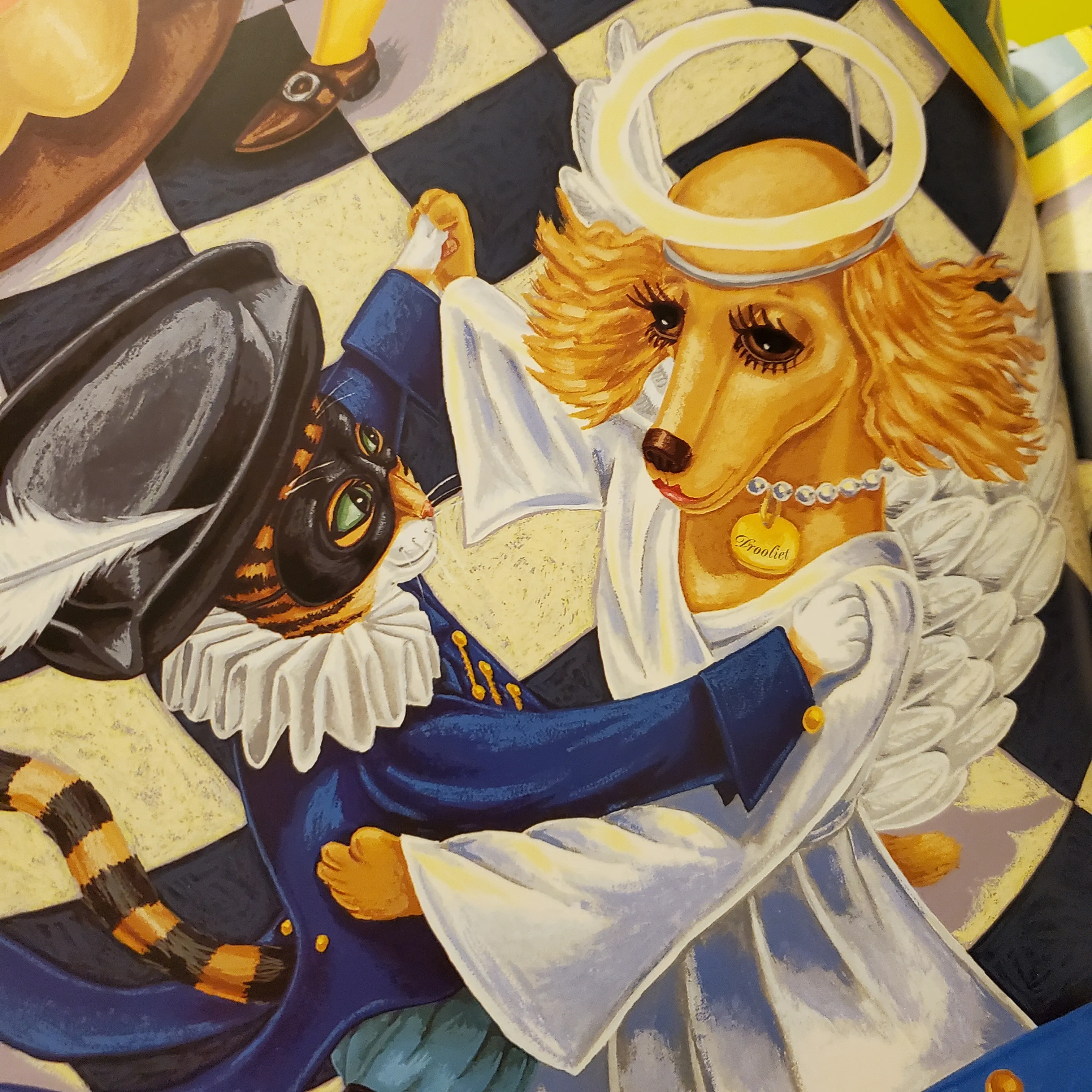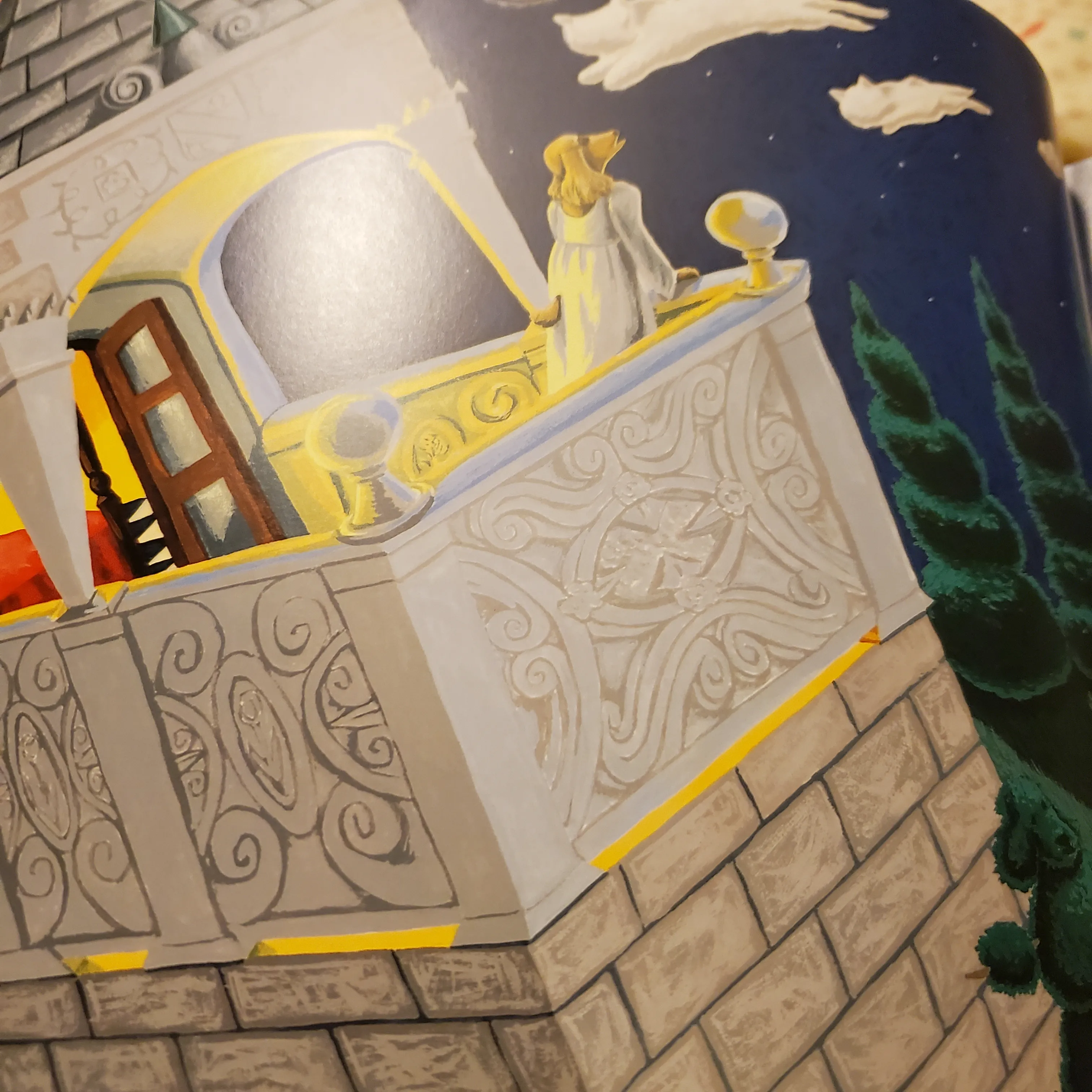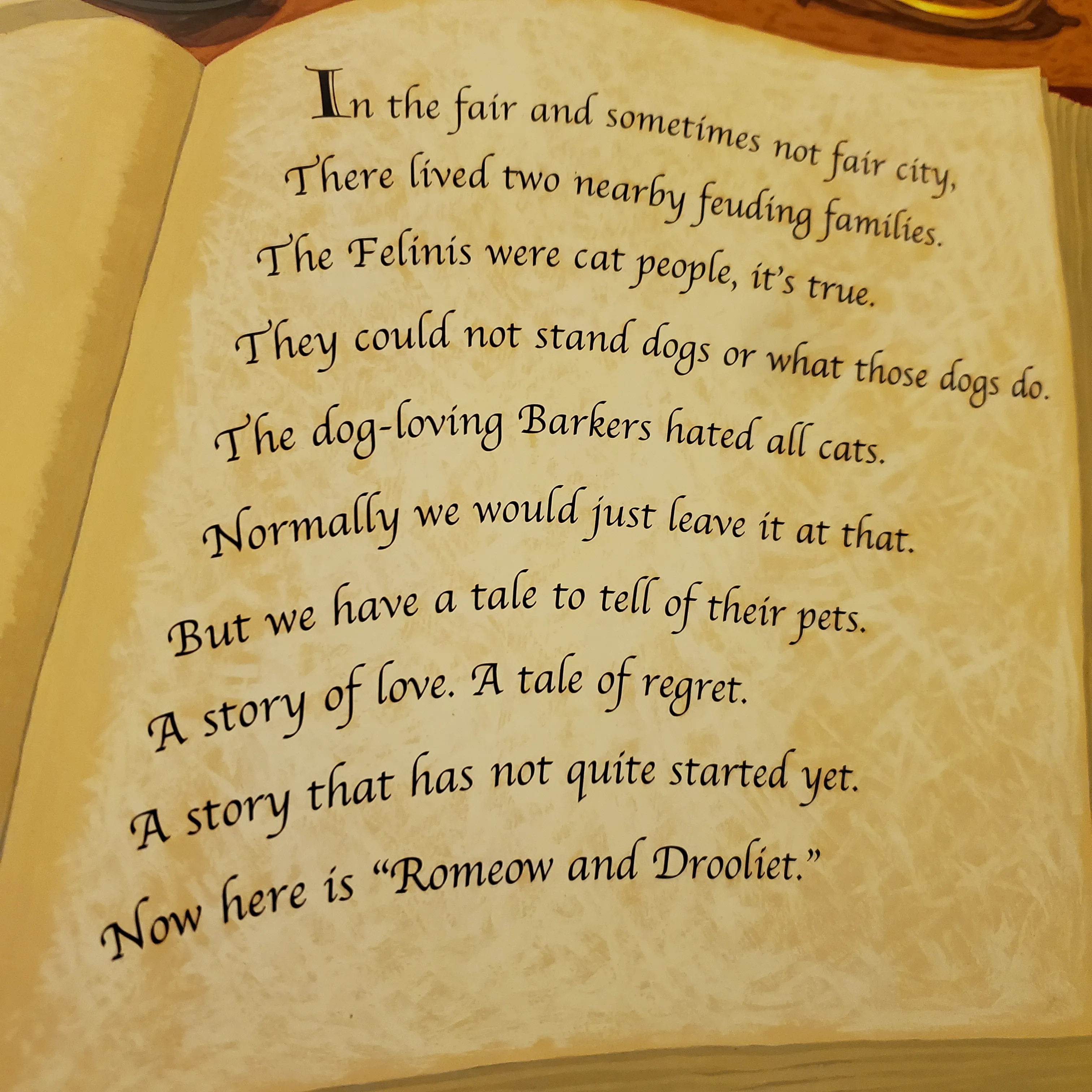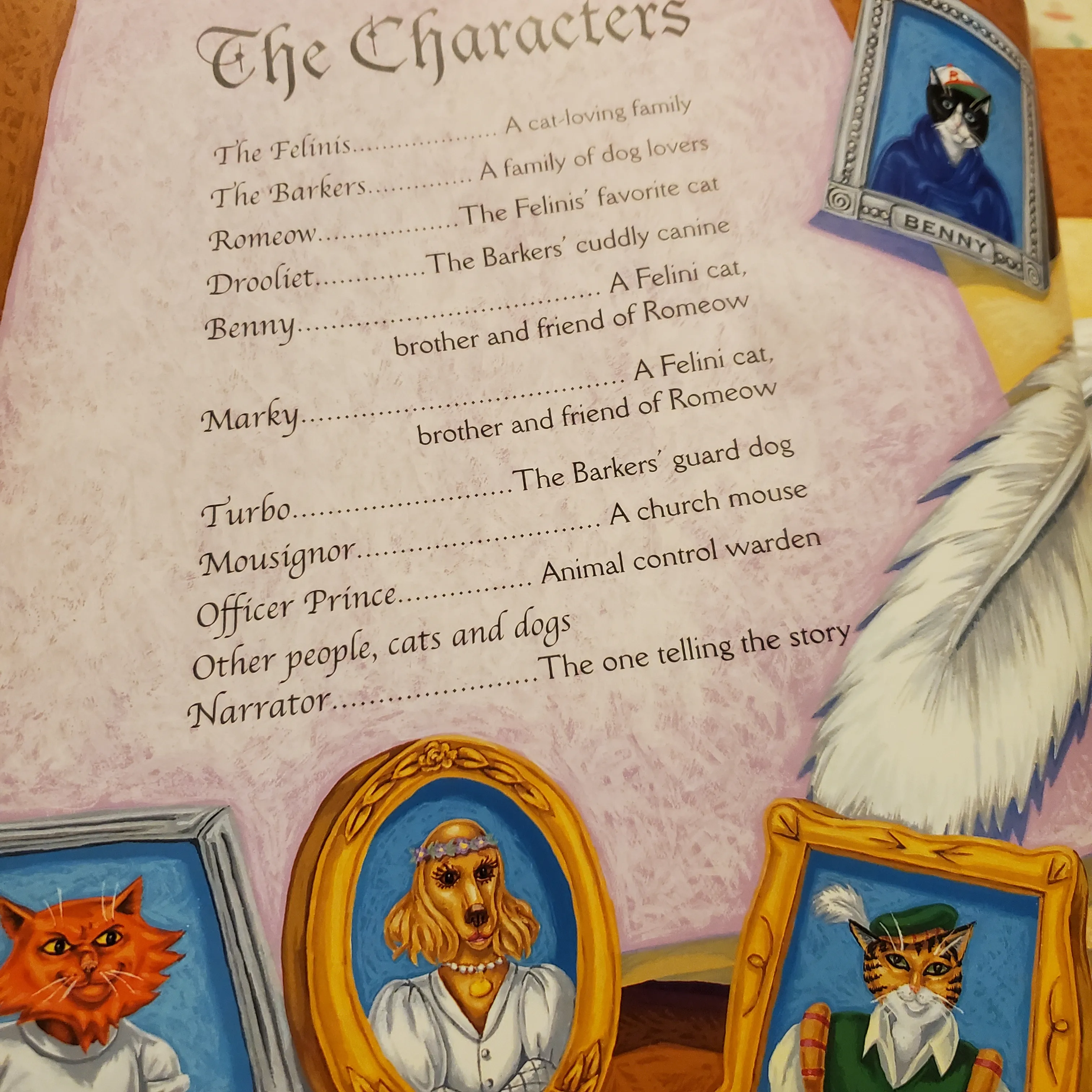Shakespeare’s timeless tale of star-crossed lovers, “Romeo and Juliet,” has inspired countless adaptations across various mediums, captivating audiences for centuries. From grand theatrical productions to animated films, the core themes of love, conflict, and fate continue to resonate. Among these creative reinterpretations, children’s adaptations hold a special place, simplifying complex narratives for younger audiences. One such delightful and inventive “Romeo And Juliet Cat And Dog Book” stands out: Nina Laden’s “Romeow and Drooliet.” This charming picture book offers a unique animal-themed twist, making the classic tragedy accessible and engaging for kids, parents, and educators alike. This review delves into how Laden skillfully transforms the Bard’s work into an unforgettable pet-friendly narrative, perfect for introducing young readers to a literary masterpiece.
The Heartwarming Premise of “Romeow and Drooliet”
Laden’s “Romeow and Drooliet” reimagines the iconic lovers as a cat and a dog, an inherently appealing concept for animal lovers. This clever casting transforms the ancient feud between the Montagues and Capulets into a relatable rivalry between natural animal adversaries. Readers are immediately drawn to these adorable characters, making their blossoming “puppy love” more understandable and sympathetic than the sometimes impulsive actions of Shakespeare’s teenage protagonists. By focusing solely on the young lovers, the book creates an intimate and emotionally resonant story, simplifying the complex human motivations of the original play into a more digestible format for children. This streamlined approach allows the essential emotional journey of Romeow and Drooliet to shine through, capturing the essence of their forbidden romance.
 The enchanting book cover of "Romeow and Drooliet" featuring a cat and a dog
The enchanting book cover of "Romeow and Drooliet" featuring a cat and a dog
Cleverly Retaining Shakespeare’s Essence
Despite its simplified premise, “Romeow and Drooliet” remarkably preserves many fundamental elements of Shakespeare’s original play, ensuring its essence remains intact. This careful balance between adaptation and preservation is what makes the book a truly brilliant work for young readers.
The Core Narrative Endures
The book faithfully maintains the central conflict of the Montague-Capulet feud, albeit between cat and dog families. Key plot points are also deftly handled, including the fated meeting of Romeow and Drooliet in disguise at a celebratory ball, their secret declarations of love during a memorable balcony scene, and their eventual marriage. Perhaps most surprisingly for a children’s book, it even incorporates a form of the tragic ending. Laden navigates these weighty themes in a kid-friendly manner, imbuing the story with appropriate emotional depth without overwhelming its young audience. The story’s pacing ensures that children can easily follow the progression of events, from initial attraction to their ultimate fate.
A Nod to Shakespearean Language and Wit
Laden’s homage to Shakespeare extends beyond the plot to the very language of the book. It begins with a rhyming prologue, echoing the function of Shakespeare’s own sonnet-form prologue: to foreshadow the plot and create a sense of dramatic irony. This clever opening immediately sets a literary tone. Furthermore, Laden skillfully imitates Shakespeare’s renowned love for wordplay, incorporating metaphors, puns (such as “a tale of tails”), and alliteration. These linguistic flourishes inject wit and effervescence into the dialogue, making the reading experience truly delightful and engaging. The sophisticated yet accessible language gives young readers a taste of the linguistic richness often found in classic literature.
 Cat and dog characters meet in disguise at a lively ball, symbolizing their initial encounter
Cat and dog characters meet in disguise at a lively ball, symbolizing their initial encounter
Ingenious Adaptations for a Younger Audience
One of the book’s greatest strengths lies in its ingenious alterations, which simplify the narrative without sacrificing its core message or emotional impact. These changes are thoughtfully implemented to enhance understanding and engagement for a younger demographic.
Streamlining the Plot and Cast
Laden masterfully streamlines the original play by excising numerous minor characters who do not directly impact the central love story. Absent are figures like Lord and Lady Capulet, Lord and Lady Montague, the Nurse, Paris, Peter, servants, and the friars. This reduction in the cast compresses an already brief play into an even more concise and focused narrative. By removing these peripheral characters, the story becomes far easier for children to follow, eliminating potential confusion and allowing them to concentrate entirely on Romeow and Drooliet’s relationship. The focused plot ensures that the emotional stakes remain clear and central to the reader’s experience.
 A detailed illustration from the book showcases witty wordplay and a rhyming prologue
A detailed illustration from the book showcases witty wordplay and a rhyming prologue
The Cat and Dog Dynamic: A Paws-itive Twist
The decision to portray the feuding families as cats and dogs is a stroke of genius. This natural animal animosity provides an immediately understandable context for the long-standing family feud, far simpler than grasping complex human political or social rivalries. Romeo and his brothers are cats, while Juliet’s family consists of dogs, creating an instant visual and conceptual distinction. An amusing detail missed by some, yet pointed out by keen observers, relates to Tybalt, traditionally known as the “Prince of Cats.” While the book makes Drooliet a dog, the choice to make Tybalt a “vicious, rabid dog” still provides a fearsome antagonist. Perhaps the most brilliant adaptation is how Laden handles the tragic ending. Employing a touch of magical realism, Romeow, being a cat, is granted nine lives. He “dies” by giving one of his lives to Drooliet, allowing both to seemingly perish but ultimately “come back” for a happy ending. This inventive resolution pays homage to the original tragedy while perfectly aligning with a kid-friendly tone, offering a satisfying conclusion without the somber finality of Shakespeare’s version.
 Illustrative depiction of the cat and dog families, highlighting their inherent rivalry
Illustrative depiction of the cat and dog families, highlighting their inherent rivalry
A Purr-fect Introduction to a Classic Tale
“Romeow and Drooliet” by Nina Laden is an absolutely delightful and highly recommended children’s book. It serves as a fantastic introduction to the enduring story of “Romeo and Juliet” for young readers, making a complex narrative accessible and engaging. The clever use of cat and dog characters, combined with witty language and a thoughtfully adapted plot, ensures that both children and adults will find joy in its pages. This “romeo and juliet cat and dog book” is not just a retelling; it’s a brilliant re-imagining that respects its source material while creating a fresh, enjoyable experience for a new generation. Parents and teachers looking for a fun and educational way to introduce literary classics will find this book an invaluable resource.
